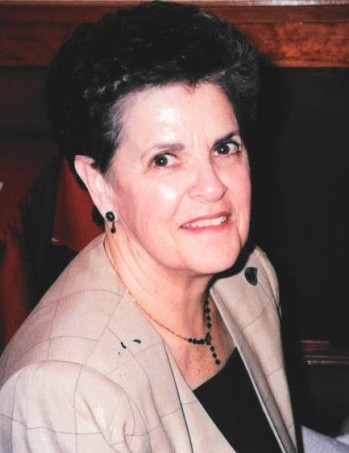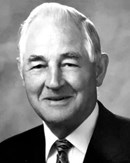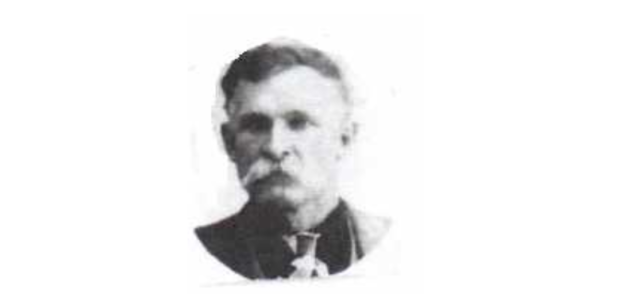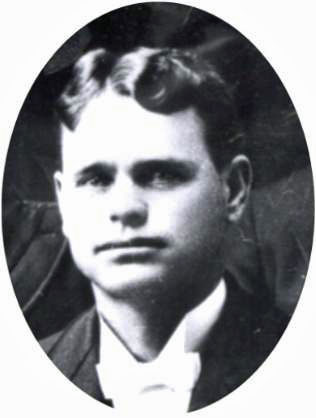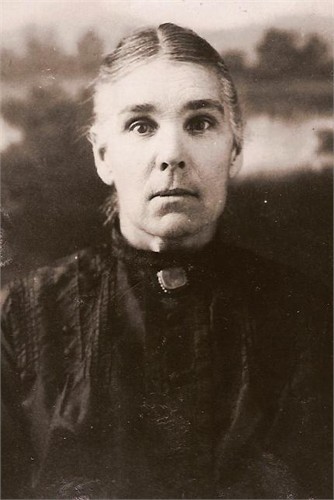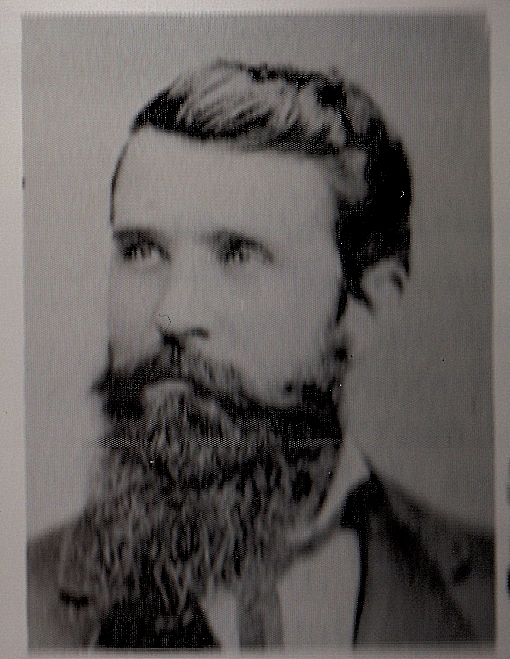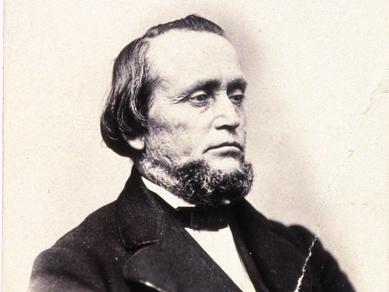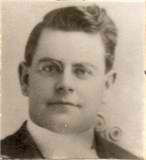Sarah Ann Lunt
1858-1921
Sarah Ann Lunt, my mother and the daughter of Edward and Harriet Wood Lunt, was born in Manti, Utah August 11, 1858. Her family later moved to Nephi, where she grew up. She early learned to spin, card and weave clothes for the needs of the family which consisted of four brothers, two sisters, and her parents.
The two older brothers were stockmen and Mother spent much time cooking for them on their ranches. She was unusual in that she knew no fear of man or beast. At one time while on the ranch an angry steer attempted to gore her and she felled him with a stone. Her formal schooling amounted to very little. She often said, “If my school days were all summed up, they would not exceed three weeks.” Yet, she learned to read and did all her own letter writing.
Henry Lunt, my father, often called on my grandfather at Nephi on his way to and from Salt Lake City to conference. One morning in the spring of 1877, returning from conference, he in Nephi for a visit. In the meantime, his team turned short and broke out the wagon tongue. Getting it repaired delayed his journey for hours, making it possible for my mother and father to get acquainted. The next time Father passed that way, he took Mother with him and they were married January 16, 1878, in the St. George Temple.
Sarah Ann Lunt immediately took control of the hotel in Cedar City. Aunt Mary Ann and Aunt Ellen, my father’s other wives, had previously taken care of the work but were not at an age of delicate health and could no longer carry on. They also had the telegraph office to look after and Aunt Ellen was kept busy with that. She was one of Utah’s first telegraph operators. The hotel and stage line were the main source of support for the entire family which consisted of Father, who was almost blind, Aunt Mary Ann, Aunt Ellen, Mother and some 20 children.
Things went well until the raids on polygamy began. Father took Aunt Ellen and went to England as a missionary for two years to avoid the law. After coming home, things were no better. So, Apostle Erastus Snow said to Mother, “Sarah Ann Lunt, it is our job to take your husband and go to Old Mexico.” Where you can acquire land as a place of refuge. We have talked to President Porfirio Diaz and he is willing to allow us to live our religion. We can build up and beautify the country. Diaz says his people are in need of being taught a better way of living and doing things. Other people are there and two settlements are already established, Colonia Diaz and Colonia Juarez.”
In response, Mother said, “Brother Snow, do you know what you are asking of me? This hotel is the only means of support for the entire family. Brother Lunt is blind and I am the only one in the family who is able to run it. We have no means and my oldest son is only eight years old.” He said, “Sister Lunt, I feel it is the will of god that you should go, and the Lord will open the way if you will but obey.” Mother prayed and fasted and thought the thing over until Apostle Snow came again. Mother was strong willed and did not act until she knew it was right.
We left Cedar City later in the evening of November 26, 1887. There were no farewells. Only the most trusted friends knew we had gone. Our party consisted of Father, Mother, Edgerton, Broughton, Parley and Edward. We took the southern route by way of “Dixie.” We went through Toquerville on to Virgin City and up a canyon called North Creek, where a family by the name of Sanders lived. It was great grape country. I will never forget the pickled grapes put down in barrels. I have never seen any since like them.
We found lodging in a two-room log house which had been used by campers as an old junk house. One of mother’s first discoveries there was that all we children were lousy. I well remember the days of scrubbing and cleaning until the pests were exterminated. Then came the measles. The remedy was sheep berry tea. It did all that any highly advertised patent medicine could do. It cured the measles. While there, we boys learned how to make slat quail traps. Father bought us a sack of wheat for bait and we climbed the sunny hillsides and found bare spots where the snow had melted off, made a trail of wheat leading to the trap, then waited for the catch. How happy we were one morning to find we had caught 13 quail in one trap. How well I remember the quail pie that night.
When the weather permitted, we moved on. We arrived in February, 1888 at Moccasin Springs, Arizona where we stayed at a stock ranch operated by Christopher Heaton. My brother, Heaton, was born there. When he was three weeks old we journeyed on, going by way of Kanab over the Buckskin Mountains to House Rock. My half-brother Oscar joined us at Pipe Springs and brought the white topped buggy. We loaded the bedding and provisions and needed camp equipment in the buggy where Mother and the children rode. The heavier goods were loaded on the big wagon. On acquiring the new fresh team and hitching them to the buggy, Mother thought it safer to ride on the heavy wagon. But even then, when going down a steep rocky hill, Mother was thrown from the wagon with the baby. In trying to protect the baby in the fall, Mother hurt her ankle quite badly. Father had her sit on a stone and he administered to her. She recovered sufficiently to continue the journey although she remained lame for months.
Mother had a natural horror of crossing the Colorado River at Lee’s Ferry. Just a short time before we crossed, a man was drowned while attempting to cross. We had to cross at the upper ferry and it necessitated going over Lee’s Backbone, a very dangerous steep mountain. I will never forget as we started down the ridge with steep canyons on both the north and the south sides, Oscar fell from the wagon, lodging on the tugs of the team on his back. The brake came off and the horses were unable to control the wagon. No matter which way it went it meant certain destruction. Luckily, Oscar regained control and all was well. On the river, men had to hold the wagon from tipping into the water.
From the Colorado to the Little Colorado is a barren waste with but little water. Most of what water was obtained had lodged in the holes in the rocks and had been there for months. Sheep had also watered at these holes and the liquid was very yellow and brackish. It always had to be boiled and some substitute flavoring added to be used at all. On reaching the Little Colorado we had a new experience. The horses were nearly famished with thirst and, seeing the water, plunged into it and sank deep in quicksand. After a great deal of exertion we finally got them out. We then traveled up the river to Winslow, Holbrook, and Joseph City, Arizona. We then went on to Snowflake and Pinedale where we stayed that summer and rented six acres of land.
Brothers Freeman and Flake let us milk a few of their range cows. Mother did the milking while the boys herded the cows and calves. The Apache Indians were not under thorough control and often broke off the reservation. We remained in Pinedale or Fish’s Ranch the winter of 1888 and I went to school at Pinedale a mile away. Joseph Smith of Snowflake was the teacher. He lived at the Fish Ranch also. Many a morning I held to one fork of his swallow tailed coat to keep from being lost in the snow as we trudged on our way to school. The summer of 1889, Aunt Annie came with her family and joined us at Pinedale with one more wagon and a team. She then took the buggy back to Cedar City. In September the rest of us took up the journey again to Mexico.
Near Show Low, a man by the name of Jeff Adams and his wife fell in with us. After traveling with us for several days, they pulled on alone and left us. The next morning, our best horse could not be found and we spent the entire day looking for him, but all in vain. That made it necessary to use one of the saddle ponies as a work horse and one boy had to walk and drive cows. In time we reached Pima on the Gila River when we camped near Franklin Scott. He had arrived some months before and had raised a small crop. He was also on his way to Mexico. Here we found our first sweet potatoes, and were they good! They grew so prolific that George went to help a man dig them on shares and found one so large that he sat on one end and put the other end in the fire to cook.
While on the Gila, Christopher Heaton, Warriner Porter and John Walser joined us with two to four families each. From then until we reached Colonia Diaz, sometime in December, 1889, our camp looked like the children of Israel in the wilderness. We would build a big fire at night. Then we children would play while the older folks would sing hymns, relate past experiences, speak of their future hopes, etc. Then we would all be called to order and Brother Walser would lead in a hymn. We would all kneel in our large circle and some of the men would pour out their souls to God for blessings of the day and ask Him to bless and watch over us and our animals as we slept. All the Porter and Heaton families came down with sore eyes and that spoiled our good play at night. I can see them still in memory bathing and trying to get their matted eyes open of a morning.
We finally reached Deming, New Mexico, a railroad town before crossing in Mexico. There we stocked up on a few things we needed, as far as our meager means allowed. Until then, we had not had a stove to cook on since we left Cedar City, nor a bestead outside of what we had made. The only furniture we had was one red and one green chair which had been made in Utah with rawhide for the seats. At Deming, father bought two cast iron cook stoves, one for each of his wives. They were still in using them when we left Mexico. He also bought two rockers, and I think a half dozen chairs. This was the sum total of the furniture we owned. We did have plenty of good homemade quilts and plenty of empty ticks which we filled with corn husks after we raised corn. We also had three feather beds and several pillows. Until the first corn crop was harvested in Pacheco, we used pine needles or pulled wild grass to fill the bed ticks.
Upon arriving in Colonia Diaz, we had to leave the only team of horses we had. They were old and nothing but mares could go on from there duty free. We also had to leave one of the cows which became too weak to travel. From Juarez to Pacheco was the end of the journey, as the notorious San Diego Canyon had to be scaled. We managed to acquire the assistance of lumber haulers who went up empty to get lumber. We arrived on what was the town site of Pacheco just as the sun was setting in the west. It had been previously surveyed and laid off into city lots, each lot containing one and one-fourth acres with wide streets and a small alley running through the blocks both ways to avoid corrals being built on the main street.
There were two small houses built of logs on the town site when we arrived, one owned by George Haws and the other by Alexander F. Macdonald, the latter being the surveyor. The town was built on a small mesa of about 200 acres, falling away to the south. A high mountain of 1800 feet to the west and a box canyon 100 feet deep on the east bracketed the town. The canyon was cut our of solid volcanic rock by the Piedras Verdas River which drained the beautiful yellow pine timber, and provided a living for most occupants of the town by affording lumber for telephone posts, railroad ties, mining timbers, and juniper fence posts. The lowlands afforded small fertile farms and grazing lands. The town proved to be a very rocky piece of ground, after the abundant grass was gone, which served as a beautiful garment when we first arrived.
We arrived in Pacheco on January 21, 1890. The next day was a busy one. We cut logs, made cribs about two feet high, then put up a ridgepole over which we stretched our wagon covers and gathered pine needles upon which we spread our quilts for beds, making as many as four children beds in each shelter. Late in the evening of the first day, one of John C. Naegle’s sons arrived at our camp with a load of lumber he had brought from a sawmill in Cave Valley and gave it to us. We used it to make a spacious kitchen and dining room by lashing a pole between two pine trees and leaning one end of the boards against the poles and letting the other end rest on the ground. This we called “the shanty.” George went to take some of the horses “off to the park” as we called it, a small valley at the foot of Garcia Knoll, and came home with a deer tied on behind him. He was only 15 and what a hero he was.
Yet other colonists soon arrived: the Scotts, Farnsworth’s, Rowley’s, Cooley’s, Blacks, Heaton’s, Porter’s, Carroll’s and many others. A log school and church house quickly erected. A ditch from Water Canyon was to be dug so we could plant orchards and gardens and have water for culinary purposes. In the meantime, all of our water was either carried or hauled in barrels from streams a mile away.
1891 was a year of severe drought everywhere and food became very scarce. Also it was an early fall and corn did not mature. George went to work on the railroad. Oscar worked at the sawmill and Edgerton went to work for Franklin Spencer. Father, Tom and I hoed corn at home. The only good team of mares we had that had reached Mexico had to be sold to make ends meet. Our suckling colts were killed by mountain lions before the first season was over. We hoed constantly. Father (who was nearly blind) had to be nearby so we could tell him which was corn and which was weeds.
Father always took one day off each week for letter writing. He couldn’t read what he wrote after writing it but by having very heavy lines drown on the paper he could follow them. Parley herded the cows to be sure they would find the best pastures and come safely home each night so that we could obtain the scanty supply of milk they gave. One day while herding cows he was bitten by a black rattler on his little toe. His leg swelled up so tight we were afraid it would burst. We did all we knew for it to no avail until the Lord heard our feeble cry and answered our prayers.
During this time, most who entered the colonies were very destitute. In Pacheco we were the only ones who had corn. The year of 1892 was a desperate one, and flour was not to be bought. The cattle were dying of starvation, but we saved our corn again and had it made into meal. I well remember how people came to borrow the corn or meal not knowing how or when they would be able to return it. I was too young to sense the gravity of the situation but can year yet the conversations that took place whenever our last sack was being dipped into. People would come to Father and say, “Brother Lunt, have you any more meal you could lend me, my family hasn’t a dust of breadstuff in the house.” His reply would be, “Ah dear brother, you will have to see Sarah.” I have heard Mother bear her testimony many times to the fact that she divided down to the last mixing and trusted in the Lord that somehow the way would open so she could feed her own. Just as the last dust was divided, here came Albert Farnsworth in from working on the “Manana (tomorrow) Railroad” with two four-horse wagons of flour. By night, Mother would have 1,000 pounds of flour in her house that had been returned for cornmeal.
In 1895 I went to work for Pleasant Williams for $.50 per day and worked until I had earned $60 for which he gave me a horse. My brother Edgerton also worked for Joshua Stevens at the same price and got another for $50. They were both two years old. We waited a year. Got them up and gentled them and it made us our first real team. The same year, Mother and I and the four youngest children, Heaton, Alma, Owen and Clarence, moved onto the Williams Ranch and rented six acres of land and 15 cows to milk. Edward was in Chihuahua City working for Lucian Mecham and his wife who were running a hotel there. Parley, Father and Tom looked after the farm in Pacheco. In order to do our plowing on the Williams Ranch we borrowed a mule from James Mortensen when he could spare it. Otherwise, Mother and I used the hoe method. We succeeded, however, in raising several tons of potatoes, a few beans and enough corn to fatten two or three big white hogs, a lot of squash and a good garden. We moved back to Pacheco for the winter and school. In those days we would have about three months of school, beginning the first of the year.
In 1897 we bought the Spencer farm at Corrales for $1,000. We also bought a small cheese factory from George C. Naegle and milked some of his cows on shares and some of Helaman Pratt’s. Mother’s cheese became famous right away and found a ready sale. Each year a box of the fruits and vegetables and products of the Mormon colonies was sent to President Porfirio Diaz as a token of our good will to him and our appreciation for letting us live in his nation unmolested. Included in each box was one of Mother’s cheeses.
Laura Ann Hardy Mecham was the first Relief Society President Pacheco had. After she moved away, Mother took her place and served as long as we lived there. During the early days of Pacheco, many of the men died due to exposure and overwork and lack of sufficient food. Examples are William Haws, John McConkie, and John Rowley. These men left large families and people had a hard time of it. Many was the day that a few of the sisters would get together and go over to spend the day with “Aunt Sarah Ann Lunt,” and when the truth was known it was to get a little food as well as have a visit. As I remember, she always had more than anyone else in town to cook. She always had a garden as we had a stream of water at all times of our won. She was a friend to the poor native people of the area as well and they loved her because she never let them go away hungry.
In 1899 our home in Corrales burned down. Since Father and Aunt Ellen were getting along in years, Mother wanted to build a brick house large enough to take care of him them, her own family, and also some spare rooms for passersby, as it seemed there were always lots of travelers in the country looking for accommodations. Mother sent to Helaman Pratt for advice, but he rather discouraged the ideas, thinking it too big a job for her and her boys with the means she had. It didn’t daunt her. We went to work and hired a man who knew how to make brick, put up a brick kiln, worked on the sawmill for our lumber and hired a boy whose father was on a mission to Denmark to lay the brick. We also hired a carpenter and builder. They all did fine work.
The house was a two-story affair, consisting of nine large rooms. We had it finished and paid for in 18 months. Sadly, this was not soon enough for Father to move into because he died on January 22, 1902. Aunt Ellen was then brought over and she died there. Aunt Annie also made her home with us for several years until she decided to live with her daughter Ellen in Pacheco.
The big house being finished and the Noroestre Railroad having been completed as far south as Terrazas, it became possible for Mother to entertain guests. The railroad advertised their road as leading into the Sierra Madre Mountains and as opening up one of the best hunting grounds in America for both small and large game. This brought many people from all over the United States and Europe to hunt. And as Corrales and the Lunt house were on the route where they outfitted and quit the wagon road, my brother George took up the hob as a guide to trappers and hunters and became the most famous guide of his day in Mexico, having trapped as many as seven bear in one week.
Our ranch, being the jumping off place into the unknown wilderness and the only place where people could get hotel accommodations, brought many people of high rank to our home. Including among them were: Theodore Roosevelt, Dr. Smith, who accompanied him on his African hunt. German barons, and English dukes and lord. At one time, William Green, the great Cananea Copper Company owner, brought man of the nation’s great men to the area, including some 27 senators. They all stayed overnight at the Lunt house. Although Mother had no education, she felt as free and at home conversing with these people as she did with her own family.
Mother placed great store by her dreams. She always had a forewarning in a dream before someone died in the community and when she was informed of some sudden death, she would often say, “That is what I saw; it was not quite clear to me, but now it is.” She was a friend to the sick and always had a little medicine and food for the needy. As material for burial clothing was hard to get, especially for members who had been through the temple, I have known her to give her own temple clothing for them to bury someone with.
At the time of the Exodus I was in the Mexican town of Toluca on a mission. The women and children of the colonies went first on a train to El Paso and later the men followed on horseback by way of Hachita, New Mexico. Rey L. Pratt was President of the Mexican Mission at the time. Most of the 22 missionaries in the Mexico City area were from the colonies and many of them had families depending on them. President Pratt, hearing of the colonists all being in El Paso, immediately went there to see what could be done. Mother met him and gave him $50 to give to me, saying, “I want him to say as long as he is needed. We will get along all right.” Although President Pratt declined to accept the money, he mind was made up and he accepted.
In the summer of 1913, she thought it her duty to go back to Mexico and put Clarence and Owen in the Juarez Stake Academy. She was made matron of the Ivins home which had become par to fht eschool and where many outside students lived. The Ivins lots were used as agricultural experiment farms. In 1919, she again returned to Colonia Pacheco, taking Alma and Clarence with her. To go back to the devastated home in Corrales where she had spent so many struggling but happy years was a trial that few women could endure. Her once beautiful home was a pile of rubble with only parts of the walls standing. Fences were gone that once enclosed fertile areas. There was no stock on the range to be looked after or bring in profit, no bawling of calves. All was silent except for the chatter of natives that gathered to greet her. A few homes of her friends had escaped the forest fires that swept the town. But the once beautiful two-story church with its spires to which she had contributed so much was a skeleton with a leaky roof and glassless windows.
Undaunted, she moved into the adobe home of her son Heaton, which had not been destroyed. President Ivins visited them in 1920 and made her youngest son, Clarence Bishop with Harlo Johnson First and William Jarvis Second Counselors. She re-fenced the fields, obtained more cows, and resumed making cheese. She was happy again. To once more be back where her husband and Aunt Ellen were buried was very important to her. She had given her first child to Aunt Ellen who was unable to have any of her own.
The Revolution continued. Firs one man would gain control of the government and then another, and each would print his own money. As the different leaders lost out, their money became valueless. The silver dollar always retained its value, but very few silver dollars could be found. Mother had 45 silver dollars laid away in a baking powder can, hidden in her flour bin, to pay her burial expenses.
During the late summer of 1921 her health failed and she suffered a long sick spell. She again had a dream. In November, for of her sons went to visit her: Broughton, Parley, Edward, and Heaton. We wanted to bring her out to Duncan, Arizona where we resided and could get the aid of a doctor. She declined, saying, “I want to stay right here. If it is the Lord’s will that I should live, He can make me well here, and if my time to die has come, I want to die and be buried here.” She told us she had dreamed of traveling and entering a deep canyon and as she traveled the walls became higher and steeper, until she reached a point where it looked as though she could go no farther. Just as she was about to give up going any father, it suddenly opened up into a beautiful valley. She said, “I don’t know whether it means I am going to get well or pass to the other side.” She felt sure there would be a sudden change for the better. Our visit did her good.
After coming home for three weeks we received a telegram from President John T. Whetten telling us that Mother was worse. So Edward, Chloe, Heaton’s wife, and myself went back to her bedside, knowing that we would bury her before we returned. We arrived at her bedside on Christmas Eve and watched over her until 6:00 pm on the 27th when she died with father’s name on her lips, gazing heavenward.
Being a carpenter, I took some of the boards my mother used to cure her cheese on and made her casket. Chloe and Lavetta lined it with white bleaching and the Johnson girls trimmed it with lace inside and out. On the 29th she was buried on the left side of her husband, Henry Lunt. Aunt Ellen, his first wife, had been buried on his right side. We dedicated the spot and poured out our souls in gratitude to God that he had given us such noble, God-fearing parents.
Broughton Lunt
Stalwarts South of the Border, Nelle Spilsbury Hatch, page 413

